We use affiliate links to run our site. When you buy through links on our site, we may earn an affiliate commission, without any added cost to you. Learn more
Earlier I have discussed two major factors that affect plant growth. Viz, Water, and Sunlight. Today I want to discuss another such important factor, temperature or heat. This article is all about how does temperature affect plant growth
The effect of temperature on the growth and development of plants varies as per plant species. Every plant has a minimum, maximum, and optimum temperature for its growth.
With global warming, the environmental temperature is increasing every day and sometimes exceeding the ideal temperature range for many species. In the future, heat waves and extreme temperatures will become more frequent and intense. This can really affect your cool-season crops like broccoli.
Extreme heat or cold can affect plants’ growth. Frost can cause sterility and abortion of formed grains while excessive heat can reduce grain production drastically.
In this post, we will discuss what are the various impacts of temperature on plants’ growth and survival and how you can prevent extreme temperature to cause harm to your plants.
Effect of Temperature on Seed Germination:
The germination process, although varies as per the species, depends quite a lot on the temperature. The optimum temperature is an essential part of germination along with air, water, and light.
We all know if the temperature drops below a certain point, the germination stops. But it is also true that if the temperature exceeds the optimal range the germination slows down dramatically.
How Does Temperature Affect Plant Growth?
Every plant has an ideal temperature range to thrive. We call this the optimum temperature of plant growth. This optimum temperature is not fixed for all plants and varies from species to species. When the temperature either drops below the optimum range or surpasses, it can affect a plant’s growth.
The effect of temperature on plants can be of two types.
- The effect of extreme cold temperature on plants.
- The effect of extreme high temperature on plants
The Effect of Extreme Cold Temperature on Plants:
If the temperature falls a little bit below the optimum temperature the rate of cell division, photosynthesis, transpiration, yield all slows down.
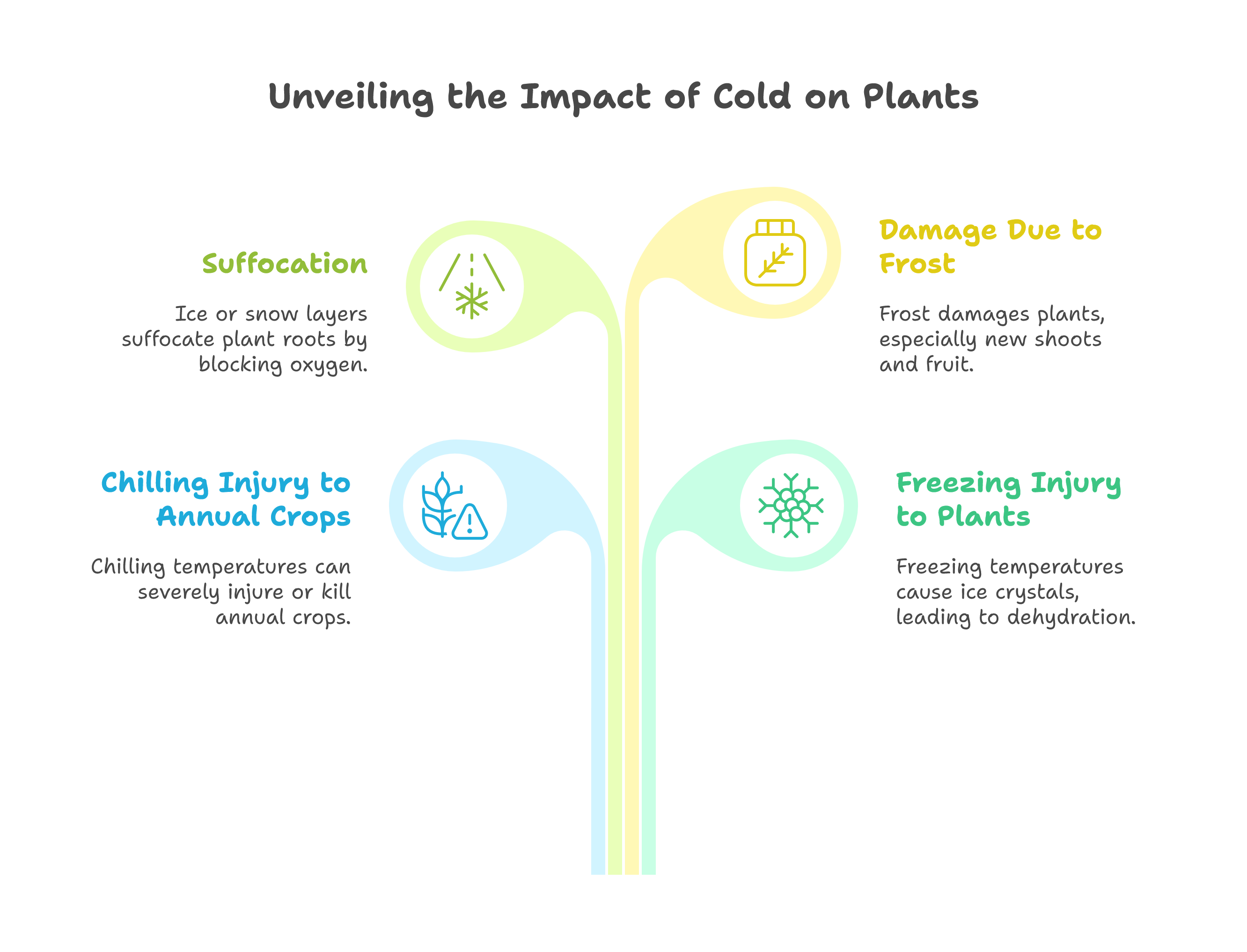
Chilling Injury to Annual Crops:
Unlike many perennials, a chilling temperature (discussed later in this post) can severely injure or even kill many annual crops.
Freezing Injury to Plants:
In plants like potatoes, tea, etc, if the temperature falls very low, the water inside the intercellular spaces of the plants freezes into ice crystals. It can result in dehydration in plants.
Can Cause Suffocation:
As the temperature drops, it can sometimes create a layer of ice or snow on the soil surface. This layer stops the entry of fresh oxygen into the soil, which in turn suffocates plants’ roots.
Damage Due To Frost:
Frost can really damage a plant, particularly if the cell size is large. Very few plants are resistant to frost. A strong frost can destroy every new plant shoot, flower buds, and newly formed fruit in most plants.
The Effect of Extremely High Temperatures on Plants:
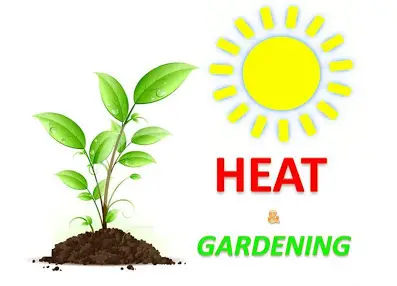
Heat stress can impact both annual and perennial plants in growth phases. Though the magnitude of the impact is different for annuals and perennials, and also it varies with the species, there is no doubt about its negative effects on plants in general.
First, let us have some insights into how a plant generally combats hot weather. The first casualty of hot weather is the loss of moisture from the plant as well as from the soil.
A few plants, like succulents, can conserve water inside their stem and leaves and thus can tackle the situation. But most of the plants show wilting in the excess heat. This can even go to a situation where the leaves will dry up, become yellow, and eventually die.
If the surrounding temperature increases mildly above the tolerance level, some plants shed their leaves to cut down on the release of water.

Plants like tomatoes, cucumbers, pumpkins, etc, stop producing and drop the blossoms, whereas cool climate plants such as cabbage, broccoli, or spinach start bolting.
If the temperature rises above 90 deg F, you might not receive the actual size of the tomato that you thought you would get.
At times, many of us might even blame the variety of the tomato for that, whereas, in most cases, it is the weather that we need to blame.
You will also find parasite infestation in the hot summer. Hot, dry weather is heaven for spider mites on plants. These insects can really damage the leaves.
Impact on Annual Crops:
Beyond a certain point, any increase in air temperatures adversely affects plant growth, pollination, reproductive processes, and crop yields.
When tomatoes face heat stress, they fail to produce viable pollen. This non-viable pollen can not pollinate flowers, so you won’t get the fruit.
Impact on Perennial Plants:
Perennials, on the other hand, are a little bit different. A handful of perennials need to be exposed to a lower temperature for flowering. These are also known as chilling hours. Plants such as apples, grapes, and cherries need this to ensure flowering. So, any increase in temperature during the winter months can impact fruiting in plants.
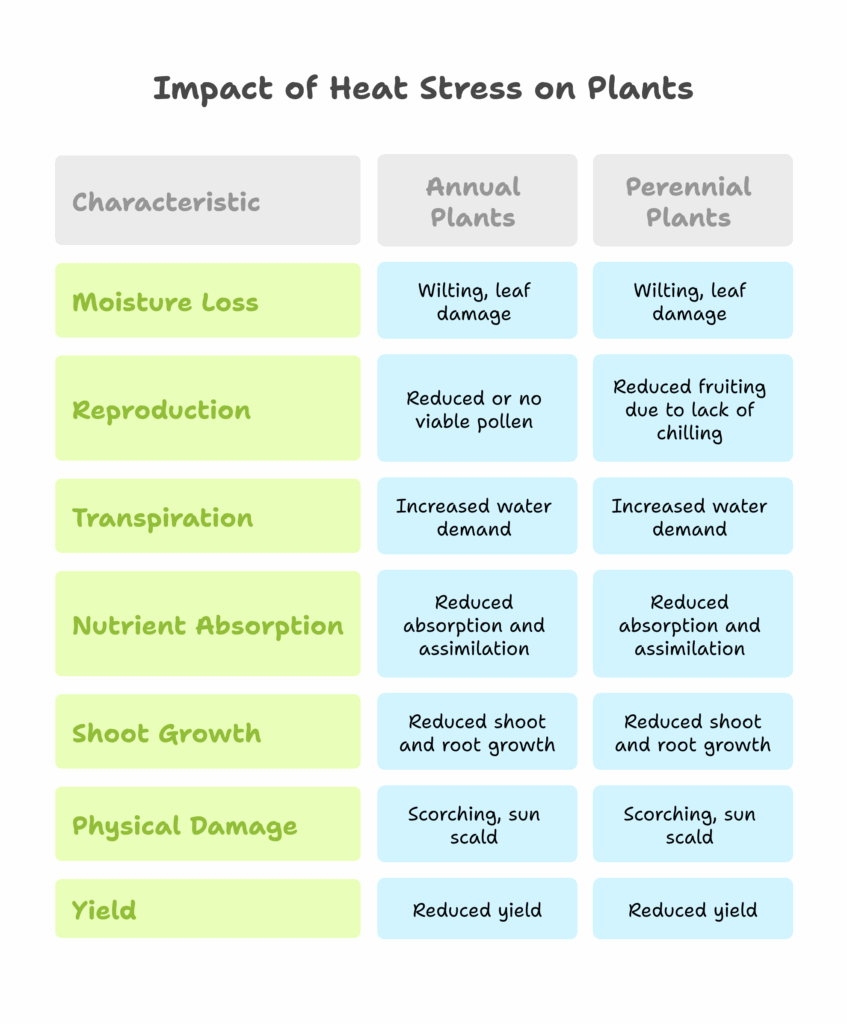
Increased Rate of Transpiration:
Another major impact of increasing temperature is the increasing demand for water vapor in the environment. This demand forces plants to transpire more water through the leaves, which in turn leads to a higher leaf temperature and a reduction in photosynthesis.
The extreme temperatures cause a two-way impact on plants. On one hand, it creates a warm air temperature that reduces fruiting in plants, and on the other hand, it increases the atmospheric demand for the plant.
Affects Nutrient Absorption:
An increased temperature causes a reduction in the absorption and assimilation of nutrients in plants. In Maize, the absorption of calcium is reduced above a temperature of 28 deg C. The nitrate reductase in plants also hampers if the temperature becomes too high.
Affects Shoot Growth:
Higher temperature affects plants’ growth, especially in temperate crops like wheat. It reduces the growth of shoots and roots in plants. This, in turn, results in a substantial reduction in the overall height of the plant.
Scorching:
High air temperature can lead to dehydration, and leaves are scorched. The injury on the exposed area of the plant is known as ‘Sun scald’
Affects Yield:
Plants that are exposed to extreme temperatures during their reproductive stage can be affected in their fruiting process.
One solution to avoid this problem is to choose plant varieties that shed their pollen when the temperature is relatively cooler.
High surrounding temperature also impacts your yield. Scientists have observed a great reduction in the yield of maize production when the temperature is increased.
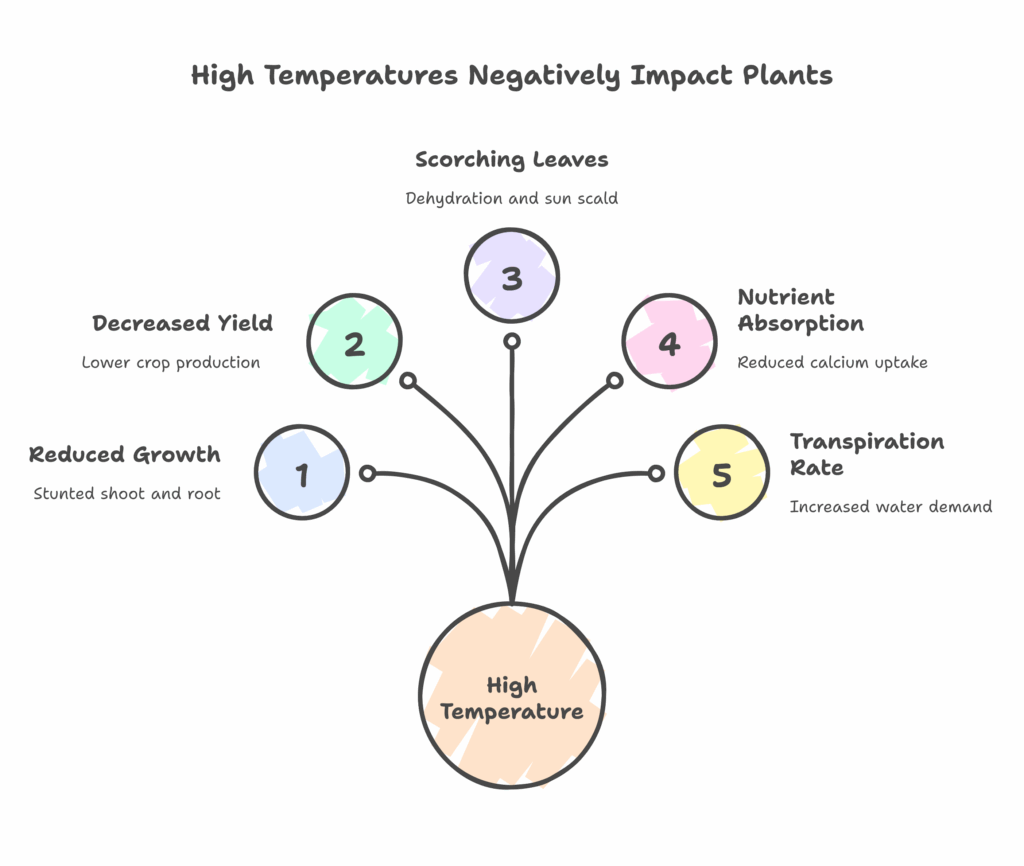
How To Protect Your Plants From Excess Temperature:
If you are growing plants, it is very important for you to understand the potential impacts of temperature on plant growth and development. So that you can make necessary changes to counter these impacts.
As extreme temperatures can have large impacts on plant growth and development, you need to protect your plants from heat waves. Though there is not much we can do to change the weather but we can really use some methods that can really minimize the damage.
Here are some steps you can take so that the heatwave does not affect your plants:
Water Properly:
First and foremost, make sure there is no shortage of water in the soil. It is the water that is responsible for carrying the nutrients from the soil to the plant in the form of sap.
So, make sure that the plants are not devoid of nutrients, in the hot summer.
For a container garden, you might need to water twice a day. It is also equally important that your soil has proper drainage.
Add different soilless mediums to the soil to increase the drainage capacity. What can be worse than keeping the plant in a waterlogged situation and let the plant rot?
Water Your Plants in The Morning:
Always try to give your plant water in the mornings. It prevents scalding. When the sun is in full swing, watering can really damage the plant. During a heatwave, you might need to water your plant more than once a day. Use manual watering methods and skip sprinklers at the time of heatwaves.
Use Protective Clothes:
One simple way to protect your plant from extreme heat is to block direct sunlight by using shade cloths or row covers. This can act as a temporary solution. You can get the clothes easily from your local nursery or from online.
They come in various sizes and shapes so you can order as per your garden size.
While covering your plants don’t forget to give enough room so that the plants can breathe and pollinators can come and pollinate the plants.
If you don’t want to spend any money, you can also use homemade shade cloths using used clothes and fishnets.
Choose Planting Locations Wisely:
Extreme heat is bad for any plant but it is worse for new transplants. This is because the roots of any transplant are shallow and prone to damage in drying conditions. Generally, you should only plant transplants once the heatwaves are over but in case you have to, plant them under partial shading offered by other tall plants.
Apply Mulch:
Another way to increase the moisture retention of the soil is by applying mulch. Mulch will also help in preventing outside heat from reaching the soil and keep the soil cool. When you apply mulch it will also reduce your watering frequency.
You can use newspapers, black plastic, straw, etc as mulch. A reflective mulch such as dry grass clippings is very helpful during heat waves. Leave freshly cut grass clippings for a few days before using them as mulch. By this time, the green leaves will become brown and will be best for use.
Mulch will also control the weeds.
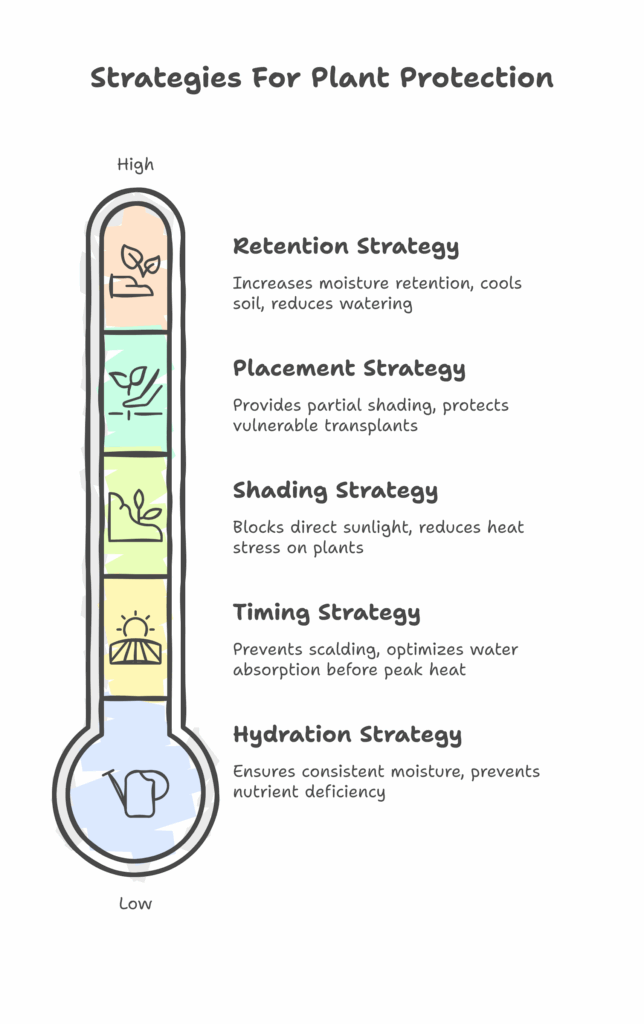
We have a detailed article on Mulch and how it functions, you can read it for more information.
A silver lining?
As they say, there are always some positives in every negative situation. This hot and dry weather can reduce various fungal diseases of plants, such as blight and powdery mildew, which are very common in the monsoon.
The extreme temperatures are very damaging for the gardens and the gardeners. I wish most of you don’t have to face these conditions, but if you had, I believe this article might have been able to solve some of your questions.
Now you know why optimum temperature is so vital for growing plants, how little bit of increase or decrease in this can hurt your plants. So these techniques discussed in this post so your plants are can fight extreme weather without damaging themselves.
Amazon and the Amazon logo are trademarks of Amazon.com, Inc, or its affiliates.
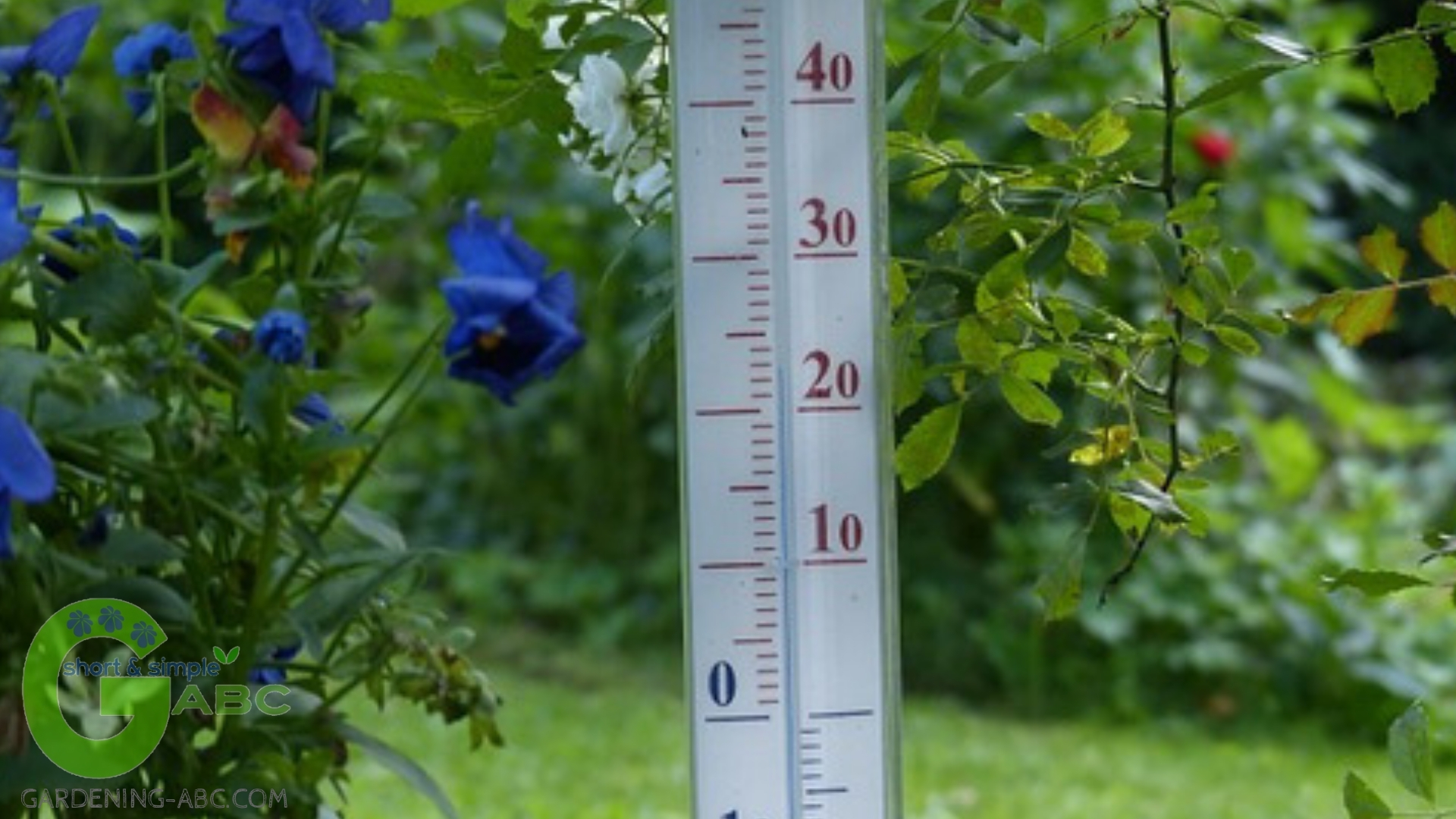
i just have a net over my backyard , but then the plants become to long , stemy is not the right word thou 🙂 – if i let it under direct sun then it just drops and then in the evening its OK..
like this – http://justwritingg.blogspot.com/2013/08/gardening-experience-in-qatar.html
keep the good work going..
gardening is all about trial and error methods. keep us posted on how you fined tuned as per as your local climate.
This a wonderful information to grow anything in in heat more especially nowadays when we are affected by climate change. thanks so much